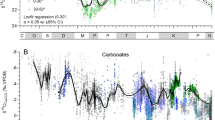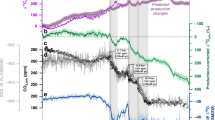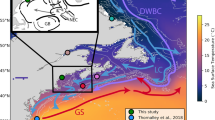Abstract
Robert & Chaussidon The possibility of a change in δ18O values of the oceans has been discussed for the past 30 years1 and the comment by Shields and Kasting2 does not really bring any new insight into this issue. The carbonate δ18O curve3 is indistinguishable from that of cherts and shows a huge scatter caused by local geological processes. This scatter in δ18O (up to 20‰ at a given age) far exceeds the sensitivity of the isotope thermometer (about 2‰ per 10 °C). It therefore prevents any precise additional test of the model and no consensus was ever reached in the literature on this debate from oxygen-isotope data alone. Our approach4, by contrast, was to try to find another isotopic proxy (δ30Si) that could bring new and independent constraints to test the hypothesis of hot oceans in the early Precambrian. Our interpretation of the δ30Si values in terms of temperature is fully coherent not only with the δ18O of cherts but also with that of marine carbonates, and certainly does not overlook these data. In addition, we indicated4 that our sample set has not the time resolution that would be necessary to look for an effect on silicon isotopes of Precambrian global glaciations. No chert samples from such periods were analysed.
This is a preview of subscription content, access via your institution
Access options
Subscribe to this journal
Receive 51 print issues and online access
$199.00 per year
only $3.90 per issue
Buy this article
- Purchase on Springer Link
- Instant access to full article PDF
Prices may be subject to local taxes which are calculated during checkout
Similar content being viewed by others
References
Perry, E. C. & Tan, F. C. Geol. Soc. Am. Bull. 83, 647–664 (1972).
Shields, G. A. & Kasting, J. F. Nature 446, doi: 10.1038/nature05830 (2007).
Kasting, J. F. et al. Earth Planet. Sci. Lett. 252, 82–93 (2006).
Robert, F. & Chaussidon, M. Nature 443, 969–972 (2006).
Lécuyer, C. & Allemand, P. Geochim. Cosmochim. Acta, 63, 351–361 (1999).
Simon, L. & Lécuyer, C. Geochem. Geophys. Geosys. 6, 1–10 (2005).
Karhu, J. & Epstein, S. Geochim. Cosmochim. Acta, 50, 1745–1756 (1986).
Author information
Authors and Affiliations
Rights and permissions
About this article
Cite this article
Robert, F., Chaussidon, M. Evidence for hot early oceans? (Reply). Nature 447, E1–E2 (2007). https://doi.org/10.1038/nature05831
Published:
Issue Date:
DOI: https://doi.org/10.1038/nature05831
This article is cited by
-
Inversion Concept of the Origin of Life
Origins of Life and Evolution of Biospheres (2012)
Comments
By submitting a comment you agree to abide by our Terms and Community Guidelines. If you find something abusive or that does not comply with our terms or guidelines please flag it as inappropriate.



